ALBANY, N.Y. — NYISO took stakeholder questions on its statement about the predicted reliability shortfall in New York City, during the Electric System Planning Working Group meeting on Tuesday.
“The short-term reliability need is primarily driven by a combination of forecasted increases in peak demand and the assumed unavailability of certain generation in New York City affected by the peaker rule,” read the ISO’s statement.
NYISO Reliability Studies Manager Keith Burrell explained the ISO was required by tariff Section 38.3.6 to explain why it was soliciting “a regulated non-generation short-term reliability solution solely from a responsible transmission owner,” which became necessary after its second quarter short-term assessment of reliably report identified that NYC could have up to a 446 MW marginal reliability deficiency by 2025. (See NYC to Fall 446 MW Short for 2025, NYISO Reports.)
“The reason the need observed in our Q2 STAR wasn’t observed in prior STAR reports was primarily due to the updated demand forecast,” said Burrell, referring to how planned fossil fuel plant retirements were included for the first time.
“We identified in our 2022 RNA [reliability needs assessment] that if demand forecast increased by as little as 60 MW there was the potential for a reliability need,” he added, “looking now at NYC forecasts, the demand went up by 294 MW when considering the baseline statewide coincident peak for estimated needs.”
Howard Fromer, who represents Bayonne Energy Center, asked if NYISO was measuring the need in MWs or MWhs.
Burrell responded, “it’s a little bit of both, when we identify a need it’s going to get the MW deficiency, but we also do some investigation to get an idea of what the hour of the need can be.”
Fromer then asked whether NYISO would entertain solutions that were less than the 446 MWs of identified need, and if some combination of regulated solutions would be considered.
“Ultimately, the solutions selected need to fully address the need but can come from multiple different options,” Burrell said. NYISO staff referred to Section 38.6.1 of the tariff to clarify what constitutes a viable and sufficient solution.
Mark Younger, president of Hudson Energy Economics, asked NYISO to further investigate statewide reliability shortfall scenarios, pointing out that the Q2 STAR also identified that at extreme loads the entire state could see marginal deficiencies. “It would be good to have some of these [scenarios] chased down before we finalize the next round of analysis,” he said.
Doreen Saia, an attorney with Greenberg Traurig, warned NYISO that whatever solution it chooses, “there are certain actions that can’t be undone,” referring to how decisions to decommission Indian Point nuclear power plant, in hindsight, seem regrettable given the state’s current reliability needs.
NYISO asked for any further comments or questions be sent to DeveloperSolution@nyiso.com before July 28. All notes will be posted online.
NYISO plans to post the third quarter STAR by Oct. 13.
NYC PPTN
NYISO also gave a status update to the ESPWG/TPAS on the public policy transmission need for New York City, which was called by the state’s Public Service Commission to deliver at least 4,770 MW of offshore wind from Long Island. (22-E-0633).
The PSC ordered another Zone J-to-K OSW transmission solution to help meet state energy goals like producing 9,000 MW of OSW by 2035, using the momentum that was built after NYISO’s board selected a project to fulfill the Long Island PPTN that called for at least 3,000 MW of export capability. (See New York PSC Calls for More Transmission for Long Island OSW.)
The NYISO has begun conducting baseline assessments for the NY PPTN to determine the actual need and what solutions are needed to meet that need. This process is followed by a 60-day window where developers can propose their own transmission solutions.
NYISO tentatively will start soliciting solutions in the first quarter of next year with the goal of the PPTN being completed by the third quarter of 2025.
NYISO promised it was actively coordinating with state agencies and other relevant parties, such as the Department of Public Service, Con Edison and the New York State Energy Research and Development Authority, in response to questions from stakeholders about the ISO’s engagement with these groups.

